FERTILIZER GIVEAWAY
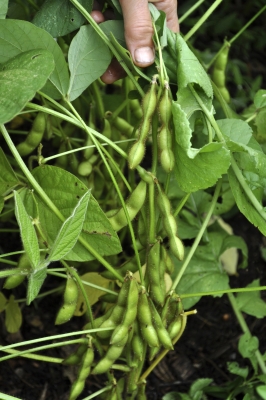
Edemame
Most Needed Food
A laundry list of things to pick up at the local garden center or hardware store this time of year likely includes fertilizer. It’s ironic that nitrogen is the fertilizer element generally needed most, yet the air contains about eighty percent nitrogen — 35,000 tons of it over every acre. The problem is like that of someone lost at sea; most plants can’t absorb nitrogen from the air.
A fortunate partnership has evolve between certain bacteria and plants that lets plants grab onto some of that airborne goodness.
Beans, Beans, They’re Good for Your . . . Garden
Most familiar among these partnerships is that of legumes and rhizobia bacteria. Legumes include garden plants like peas, beans,
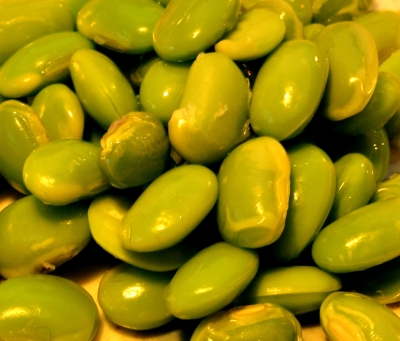
Edamame, shelled
and lupines, in addition to field plants like clover and vetch, and trees like honeylocust, black locust, and golden chain tree. In order to use atmospheric nitrogen, legumes must be infected with special strains of bacteria.
You can make sure your peas and beans are infected with the right bacteria by buying a legume inoculant when you buy your pea and bean seeds. This black powder (the bacteria comes mixed in dry peat) is applied either by shaking it with moistened seeds before sowing, or dusting it directly over seeds in the furrow. As soil moisture stirs seeds out of dormancy, it also awakens the bacteria. The bacteria proceed to infect newly emerging legume roots and the roots respond by forming nodules. These nodules are obvious to the naked eye on plant roots.

Nodules on pea roots
Within the nodules, bacteria convert gaseous nitrogen from the air into soluble nitrogen, which is pumped up into the plant. In return for these efforts, the bacteria exact a parcel of the carbohydrates produced by the host plant. The relationship is symbiotic, beneficial to both the host plant and the bacteria. In one study with soybeans, inoculated plants had a sixty-seven percent greater yield than plants that had not been inoculated.
There is some specificity between strain of bacteria and type of legume, though for vegetable gardens, a combined pea and bean inoculant is what is commonly sold. A different strain would be needed for soybeans or for clover, though.
Soil inoculated with the appropriate bacteria rarely needs re-inoculation. Inoculation is needed for new gardens, for soils in which peas or beans have not been grown for many years, and for soils subject to heavy chemical use (with either fertilizer or pesticides).
All parts of legume plants, and especially the seeds, which we eat, are rich in nitrogen and, hence, protein. As an infected plant in the ground ages, old nodules and roots slough off and then bleed nitrogen into the soil. If the plants’ leaves and stems are dug into the soil after the beans have been harvested, the soil is further enriched. In traditional agriculture, where use of petrochemical-fueled fertilizer is not available, legumes are used to supply nitrogen for succeeding crops. “Modern” agriculturalists have utilize this symbiosis with interplantings or successive cropping of corn and soybeans.
I delve more deeply into practical aspects of nitrogen fertilization in my book The Ever Curious Gardener : Using a Little Natural Science for a Much Better Garden.)
You can even tap into this free nitrogen of legumes on a backyard scale. Too much nitrogen fertilizer is wasteful since it suppresses the bacterial symbiosis, so limit nitrogen use. I often check the roots of some of my pea and bean plants after harvest to see if they are well-nodulated. If all I see are bare roots, either the plants need inoculation, or there’s too much nitrogen in the soil.
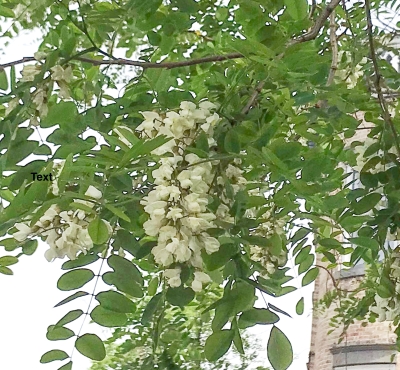
Black locust in flower
A lawn can also make use of this symbiosis if some legume — clover, for example — is allowed to share some space with the lawngrass. Studies in England showed that under ideal conditions clover might supply up to 100 pounds per acre of nitrogen to grass in a pasture. Even if the clover supplies only a quarter that amount (which may be more realistic for a lawn), this is equivalent to spreading the nitrogen equivalent of more than five pounds of 10-10-10 fertilizer every thousand square feet of lawn.
To really maximize use of “free” nitrogen, inoculate legumes and use them as part of a crop rotation. In gardens that are large enough, a portion or some bed or beds can be set aside solely for this purpose each season. The actual amount of nitrogen added to the soil depends on the plant and environmental conditions. A legume might add, on average, about three quarters of a pound of nitrogen per hundred square feet. This translates to almost eight pounds of a 10-10-10, which is a typical recommendation for chemical fertilizer for a vegetable garden.
And More Free Helpers
Rhizobia aren’t the only kids on the block when it comes to bacteria that can funnel that airborne nitrogen into a form that plants can use.
Frankia are another group of bacteria, these forming associations with so-called Actinorhizal plants. (Frankia used to be classified as an actinomycete, another kind of microbe.) Frankia isn’t a name that gets thrown around as much as rhizobia, but you’ve likely come across Actinorhizal plants such as seaberry (delicious fruit), broom, and bayberry.
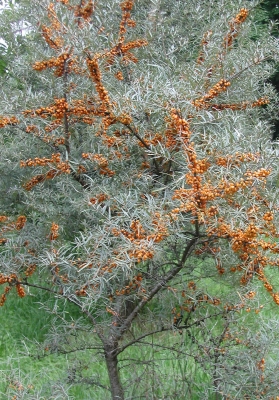
Seaberry
And you’ve surely come across autumn olive and Russian olive, reviled by many gardeners (not me) for being non-native and invasive, despite the fact that they bear deliciously fragrant flowers (now in bloom) and tasty fruit, are decorative, and, of course, enrich the ground with free nitrogen.
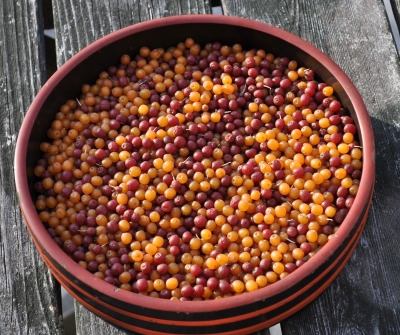
Autumn olive fruit, ready to eat
All the previously mentioned nitrogen fixers meet their energy requirements with carbohydrates from their host plants. Some nitrogen fixers do their work without a host plant. Soil bacteria in the genera Azobacter, Bacillus, and Clostridium fuel themselves with soil carbon locked up in the soil as organic matter. Another group, chemolithotrops, fuel themselves with inorganic molecules such as various forms of sulfur, iron, or phosphorous in the soil. Many thrive in oxygen-poor environments.
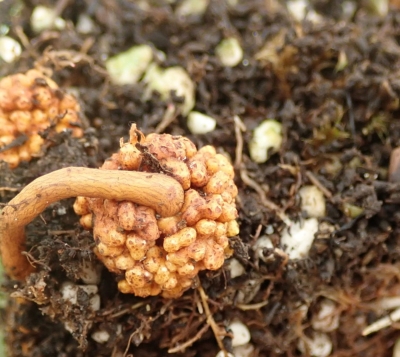
Frankia nodule on alder roots
The simplest way to get all the nitrogen fixers to do their best work is, besides inoculating as needed, is to build up levels of soil organic matter with regular additions of raw organic materials such as leaves and straw, or compost. Also keep the soil covered (such as with a mulch of leaves, straw, or compost). Minimize tillage, which unduly speeds oxidation of organic matter. And limit use of nitrogen fertilizers, which meshes well with the the other points because organic materials can fulfill all or a good part of plants’ hunger for nitrogen. And guess what? All this is more or less Mother Nature’s m.o.

Laburnum, a legume


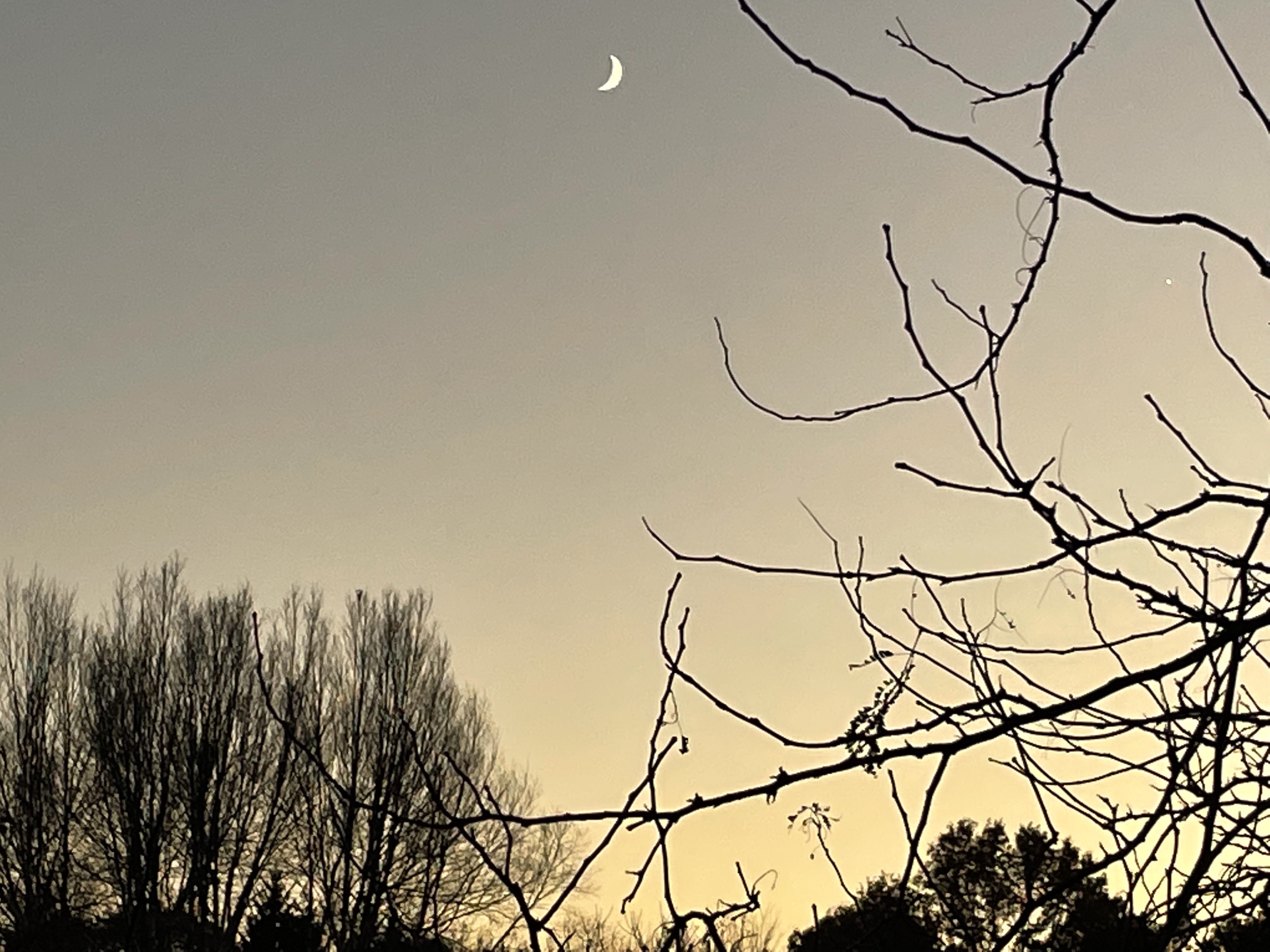

Hey Lee,
I’ve been thinking about whether I could use legumes as the primary source of fertility within my garden, but wondering what the rotation might look like. The idea is that this might be a more efficient way of fertilizing as opposed to making and spreading compost (especially over very large gardens/farmdens). Say I’m not adding anything to my no-till beds (no compost or soybean meal) besides various mulches periodically throughout the year. Then every other bed within the garden would be dedicated to growing some legume so my rotation from year to year is to simply shift all the beds over to where a legume was growing the previous season.
Do you think such a growing plan would work for providing all my vegetable gardens fertility needs?
Since the N-fixing ability ranges from legume to legume, are there “key” one’s you’d recommend I stick to in the rotation? …soybean & peas?
Would every other bed in legumes be overkill? …that’s a lot of beans & such.
Would it be advisable to manage each of the legume beds strictly as a cover crop in which I don’t partake of the harvest but rather grind up the seed and spread over the beds? Or will most legumes be generous enough to feed my family while still supplying all my gardens fertility needs?
What do you think of the idea of “sheet mulching/composting” with the old legume plants by which I cut and lay the plants down in the bed at the end of a season and immediately cover the plant debris with another layer of mulch/leaves? Would that help add/retain more nitrogen or is it not worth it because of potential disease issues?
Fertility isn’t only about nitrogen. Besides other nutrients, organic materials important to increase or maintain the soils organic matter (humus) content. Mulches and legumes could work for what you want, even mulches alone if you have enough. They would build up a good store of N in the soil over time.
As far as what legumes, I would look up what does well in your area and how much N can be expected from those legumes. A typical N recommendation for vegetables, generally, might be 100#/A or 0.25#/100 sq. ft. of actual N. Harvesting any of the legume would decrease the N offered.
I like the idea of sheet mulching except that it would make planting small seeds difficult. A good book for more information, Besides my own book, WEEDLESS GARDENING (www.leereich.com/books), is Ruth Stout’s entertaining classic HOW TO HAVE A GREEN THUMB WITHOUT AN ACHING BACK. A very well drained soil is important for her technique to work. Her garden was in sand.